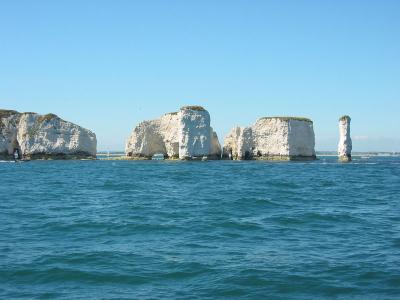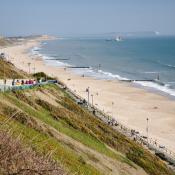The stretch of coastline between Orcombe Point near Exmouth in East Devon and Old Harry Rocks near Swanage in Dorset was given UNESCO World Heritage Site status in 2001 in honour of the unique insight it offers into 185 million years of the world’s geological history.

The story of this 'Jurassic Coast' began 250 million years ago in the Mesozoic Era, known as the 'Middle Ages' of life on earth and comprising the Triassic, Jurassic and Cretaceous periods of geological time.
During the Triassic period (250-200 million years ago) the site was part of a super-continent known as Pangaea. Dorset and Devon fell within the arid centre of this continent and hot, desert conditions prevailed, evidenced by the spectacular red colour of the cliffs around Orcombe Point. The Triassic period saw the evolution of the first true mammals and the first dinosaurs, who went on to dominate life on earth during the Mesozoic Era.
Pangaea began to break apart during the Jurassic period (200-140 million years ago) as the Atlantic opened and the Americas drifted away. Marine conditions during this period are recorded in the Jurassic rocks of Dorset and East Devon; sea-levels rose and fell depositing deep water clays, sandstones and shallow water limestones. The cliffs at Charmouth are rich in the fossils of animals that swam in Jurassic seas and, as the coast here erodes rapidly, the beach is one of the safest and best places in Europe to look for fossils. The fossil remains found at Charmouth offer one of the richest slices of life in Jurassic times in the world while the neighbouring Lyme Regis was home to Mary Anning, who found the first complete Icthyosaur, and has been called 'the greatest fossilist who ever lived'. New and spectacular finds are still being made in the area such as the nearly complete three meter skeleton of the dinosaur Scelidosaurus, a species unique to Lyme Regis and Charmouth. The sequence of rocks at Kimmeridge in west Dorset provide such an excellent record of the Jurassic period that geologists have adopted 'Kimmeridgian' as the term for rocks of this age all over the world.
Towards the end of the Jurassic period sea levels dropped and a number of islands emerged in the Purbeck area of Dorset, surrounded by channels of salt water. Forests of giant cypress and ferns flourished before being flooded under a shallow salt water lagoon. Thick blankets of algae grew across the forest floor and around the base of trees and fallen logs and sediments stuck to the algae and grew over time into large lumps, known as ‘burrs’ and shaped like doughnuts. These are preserved today in what is known as the Fossil Forest, most easily viewed from a ledge to the east of Lulworth, and comprising the most complete record of a Jurassic Forest in the world.
America continued to drift away during the Cretaceous period (140-65 million years ago) and the site would have been home to lush swamps populated by fearsome dinosaurs. A wealth of Cretaceous fossils have been found in the Purbeck Beds including dinosaur footprints and the microscopic teeth of mammals.
Chalk formed during the Cretaceous period, from microscopic algae. The picturesque fishing village of Beer in Devon is famous for the layer of stone known as 'Beer Chalk' found just behind the village and consisting of densely-packed minute shell fragments. This high-quality masonry stone has been quarried since Roman Times and the Beer quarry caves cover an area larger than fifty football pitches.
Coastal processes are an integral part of the geology of the Jurassic Coast. The Undercliffs between Axmouth and Lyme Regis, for example, are one of the most important wilderness areas in Britain. Now managed by English Nature, the entire reserve was formed by landslides that still occur today giving rise to an internationally important mixture of habitats and a great variety of plants and animals. Meanwhile between Lyme Regis and Burton Bradstock the Black Ven was the site of the largest coastal mudslide in Europe when, in 1958 and 1959 two huge mudslides spilled onto the beach.
Beaches are, naturally, a feature of the region, and none are more dramatic than the world-famous Chesil Beach. One of the finest examples of a barrier beach in the world, Chesil Beach’s seventeen miles of pebbles and shingle, which reach a height of fifteen meters near the Portland end, have resisted thousands of years of Atlantic storms and given rise to continuing debate over why the stones increase in size as they move east. Geographers have yet to find a theory of the origin of Chesil Beach that explains all of its attributes.
Behind the beach, and protected by it, is the Fleet, the largest tidal lagoon in Britain and an internationally important habitat for birds and marine wildlife including the oldest managed swan population in the world.
Perhaps the most famous coastal landform on the Jurassic Coast is Lulworth Cove, which demonstrates how the sea has acted on rocks of differing resistance over time. In this case the near-perfect cove has been formed by a stream breaching the outer band of resistant limestone and thus allowing the sea to enter and hollow out the softer clays behind until at the back of the bay chalk forms a resistant cliff. Half a mile to the west of Lulworth is Durdle Door, a near-perfect coastal arch.
The site ends just after the great chalk headland of Ballard Down and the sea stacks known as Old Harry Rocks. From the sea the chalk cliffs are even more dramatic than they appear from land as an unusual curved fault separates vertical strata in Swanage Bay from horizontal strata to the north. Ballard Down, owned by the National Trust, is an outstanding down habitat with the wild chalk flora giving rise to many species of rare butterflies including the Adonis Blue and the Chalk Hill Blue.
The South West Coast Path runs along the entire stretch of Jurassic coast, which is also well-served by cycle routes and numerous boat trip tours leaving from many of the major gateway towns such as Exmouth, Charmouth, Lyme Regis, Seaton, Sidmouth and Swanage.
Purbeck

















